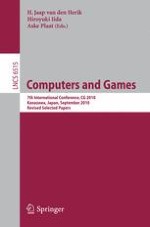This book constitutes the refereed proceedings of the 7th International Conference on Computers and Games, CG 2010, held in Kanazawa, Japan, in September 2010. The 24 papers presented were carefully reviewed and selected for inclusion in this book. They cover a wide range of topics such as monte-carlo tree search, proof-number search, UCT algorithm, scalability, parallelization, opening books, knowledge abstraction, solving games, consultation of players, multi-player games, extraversion, and combinatorial game theory. In addition a wide range of computer games is dealt with, such as Chinese Checkers, Chinese Chess, Connect6, Go, Havannah, Lines of Action, Pckomino, Shogi, Surakarta, and Yahtzee.
